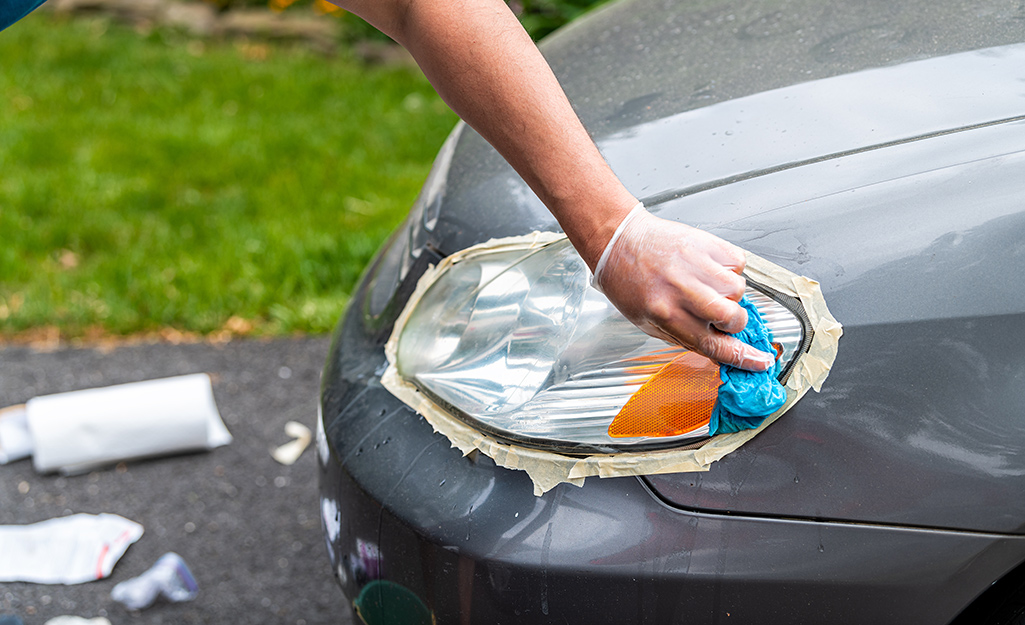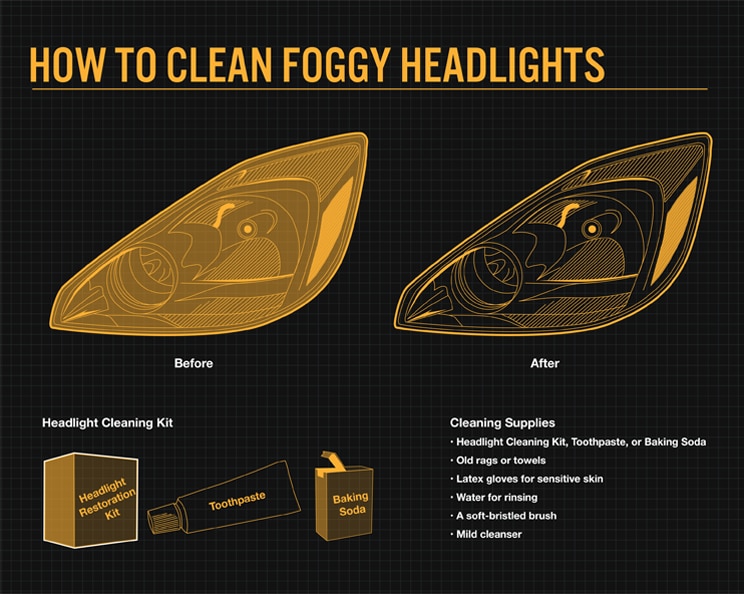To clean headlight lens, use a headlight restoration kit following the manufacturer’s instructions. Regular cleaning improves visibility and enhances the car’s appearance.
Dirty or foggy headlight lenses can reduce visibility, making it harder to see at night or in poor weather conditions. By cleaning the headlight lens, you can ensure optimal performance and safety on the road. In addition, a clean headlight lens can improve the overall aesthetic appeal of your vehicle, giving it a fresh and well-maintained look.
Regular maintenance of the headlight lens is essential for safe driving and vehicle upkeep.
Contents
- 1 Why Headlight Lenses Become Cloudy
- 2 Why Clean Headlights Matter
- 3 The Dangers of Neglecting Headlights
- 4 How to Clean Headlight Lens
- 5 Maintaining Clear Headlight Lenses
- 6 Frequently Asked Questions
- 6.1 How Often Should I Clean My Headlight Lens?
- 6.2 What Is The Best Way To Clean A Headlight Lens?
- 6.3 Can I Use Toothpaste To Clean My Headlight Lens?
- 6.4 How Do I Prevent My Headlight Lens From Getting Foggy?
- 6.5 What Causes Headlight Lenses To Turn Yellow?
- 6.6 Should I Replace My Headlight Lens If It Is Severely Damaged?
- 7 Conclusion
Why Headlight Lenses Become Cloudy
Headlight lenses are typically made of polycarbonate plastic, which is durable but prone to oxidation and damage from UV rays. The cloudiness or yellowing occurs due to:
- UV Exposure: Prolonged exposure to sunlight causes the plastic to degrade.
- Environmental Contaminants: Dirt, grime, road salt, and chemicals can adhere to the lens surface.
- Oxidation: The plastic oxidizes over time, resulting in a cloudy or hazy appearance.
- Physical Damage: Small scratches from road debris can accumulate, further dulling the lens.
Why Clean Headlights Matter
It is very important to keep headlight clean for the following reasons –
1. Improved Visibility
The primary function of headlights is to illuminate the road ahead, allowing drivers to see clearly in low-light conditions. Clean headlights ensure that the maximum amount of light is projected onto the road, enhancing visibility and helping drivers identify obstacles, pedestrians, and road signs more effectively.
Dirty or foggy headlights can significantly reduce the range and intensity of light, making it harder to see and increasing the risk of accidents.
2. Enhanced Safety
Safety is paramount when driving, and clean headlights contribute significantly to it. According to the National Highway Traffic Safety Administration (NHTSA), around 50% of fatal car accidents occur at night, even though only 25% of driving happens during nighttime hours.
One of the factors contributing to this statistic is poor visibility due to inadequate lighting. Clean headlights ensure that your vehicle is visible to other drivers and that you can see the road clearly, reducing the likelihood of collisions.
3. Legal Requirements
In many regions, there are legal requirements regarding the condition and functionality of vehicle headlights. Law enforcement officers can issue citations for vehicles with non-functional or excessively dirty headlights. Ensuring your headlights are clean and operational can help you avoid fines and ensure compliance with local traffic laws.
4. Improved Aesthetics
Clean headlights also contribute to the overall appearance of your vehicle. Cloudy, yellowed, or dirty headlights can make even a well-maintained car look older and neglected. Regular cleaning and maintenance of your headlights can enhance the aesthetic appeal of your vehicle, making it look newer and more attractive.
The Dangers of Neglecting Headlights
Neglecting your headlights can lead to several issues, including:
- Reduced Light Output: Dirt, grime, and oxidation can diminish the brightness of your headlights, making it harder to see at night or in poor weather conditions.
- Increased Accident Risk: Poor visibility can lead to accidents, as drivers may not see obstacles, pedestrians, or other vehicles in time to react.
- Vehicle Damage: Over time, neglected headlights can become permanently damaged, requiring expensive replacements rather than simple cleaning or restoration.
- Legal Issues: As mentioned, driving with dirty or non-functional headlights can result in legal penalties.
How to Clean Headlight Lens
There are two methods of cleaning headlight. These are –
- DIY Methods
- Professional Headlight Restoration
1. DIY Methods for Cleaning Headlight Lenses
Follow the steps and tips below to do the job –
1. Soap and Water Cleaning
This is the most basic method and is often used as a first step before applying more intensive treatments.
Materials Needed:
- Mild car soap
- Water
- Microfiber cloth or sponge
- Soft-bristle brush (optional)
Steps:
- Mix car soap with water to create a soapy solution.
- Rinse the headlight lenses with water to remove loose dirt.
- Dip the microfiber cloth or sponge into the soapy solution and scrub the lenses.
- Use a soft-bristle brush for stubborn dirt if necessary.
- Rinse thoroughly with clean water and dry with a microfiber cloth.

Credit: www.homedepot.com
2. Toothpaste Method
Toothpaste, especially those with mild abrasives, can be effective in removing surface oxidation and minor scratches.
Materials Needed:
- Toothpaste (non-gel, whitening varieties work best)
- Microfiber cloth
- Water
Steps:
- Clean the lenses with soap and water as described above.
- Apply a small amount of toothpaste to the microfiber cloth.
- Rub the toothpaste onto the headlight lens in circular motions, applying gentle pressure.
- Continue rubbing for a few minutes until the lens feels smooth.
- Rinse the lens with water and dry with a clean microfiber cloth.

3. Baking Soda and Vinegar
A mixture of baking soda and vinegar creates a mild abrasive that can help clear oxidation.
Materials Needed:
- Baking soda
- White vinegar
- Microfiber cloth
- Water
Steps:
- Mix equal parts baking soda and vinegar to form a paste.
- Apply the paste to the headlight lens using a microfiber cloth.
- Rub the mixture onto the lens in circular motions.
- Let it sit for a few minutes.
- Rinse thoroughly with water and dry with a microfiber cloth.
4. Commercial Headlight Restoration Kits
These kits are designed specifically for headlight restoration and usually include sanding discs, polishing compounds, and UV sealants.
Popular Kits:
- 3M Headlight Restoration Kit
- Turtle Wax Headlight Lens Restorer
- Sylvania Headlight Restoration Kit
Steps:
- Follow the instructions provided in the kit.
- Typically, the process involves sanding the lens with different grit sandpapers, polishing the lens with a compound, and applying a UV sealant to protect against future oxidation.
2. Professional Headlight Restoration
If DIY methods do not achieve the desired results, or if you prefer a professional touch, headlight restoration services are available. Professional services use advanced tools and techniques to restore headlight clarity and provide a more durable finish.
Benefits of Professional Restoration:
- High-quality results with minimal effort on your part.
- Advanced UV sealants that provide longer-lasting protection.
- Professional-grade tools and compounds for deeper restoration.
Finding a Professional Service:
- Look for auto detailers or body shops that offer headlight restoration services.
- Read reviews and ask for recommendations to ensure you choose a reputable provider.
- Inquire about the materials and techniques they use, and ask for before-and-after photos of their work.

Credit: www.bridgestonetire.com
Maintaining Clear Headlight Lenses
After restoring your headlight lenses, regular maintenance can help keep them clear and prevent future oxidation.
Tips for Maintenance:
- Regular Cleaning: Clean your headlights regularly with soap and water to remove dirt and contaminants.
- Waxing: Apply a layer of car wax or a dedicated headlight lens protector every few months to add a protective barrier.
- Parking: Whenever possible, park your vehicle in a garage or shaded area to reduce UV exposure.
- UV Sealants: Periodically apply a UV sealant designed for headlights to prolong the clarity of the lenses.
Frequently Asked Questions
Here are some FAQs about the headlight cleaning –
How Often Should I Clean My Headlight Lens?
It is recommended to clean your headlight lens at least once every three months to maintain optimal visibility.
What Is The Best Way To Clean A Headlight Lens?
To clean a headlight lens, start by washing it with mild soap and water. Then, use a specialized headlight cleaner and a soft cloth to remove any stubborn stains or oxidation.
Can I Use Toothpaste To Clean My Headlight Lens?
Yes, toothpaste can be used as a DIY headlight cleaner. Apply a small amount of toothpaste to a cloth and gently rub it onto the lens in circular motions. Rinse thoroughly and dry.
How Do I Prevent My Headlight Lens From Getting Foggy?
To prevent foggy headlight lenses, make sure they are properly sealed. Applying a protective coating can also help. Additionally, avoid using high-pressure car washes that may damage the seal.
What Causes Headlight Lenses To Turn Yellow?
Headlight lenses can turn yellow due to prolonged exposure to sunlight, oxidation, and environmental contaminants. Regular cleaning and maintenance can prevent or reduce yellowing.
Should I Replace My Headlight Lens If It Is Severely Damaged?
If your headlight lens is severely damaged, it is recommended to replace it. Cracks, deep scratches, or cloudiness that cannot be restored may affect visibility and compromise safety.
Conclusion
Cleaning your headlight lens is a simple yet essential task to ensure optimal visibility while driving. By following the step-by-step guide provided in this blog post, you can effectively remove dirt, grime, and oxidation from your headlight lens. Remember to use the recommended tools and cleaning agents to avoid any damage.
Regular maintenance of your headlight lens will not only enhance the appearance of your vehicle but also improve safety on the road. Keep your headlights shining bright and enjoy a clear view ahead.